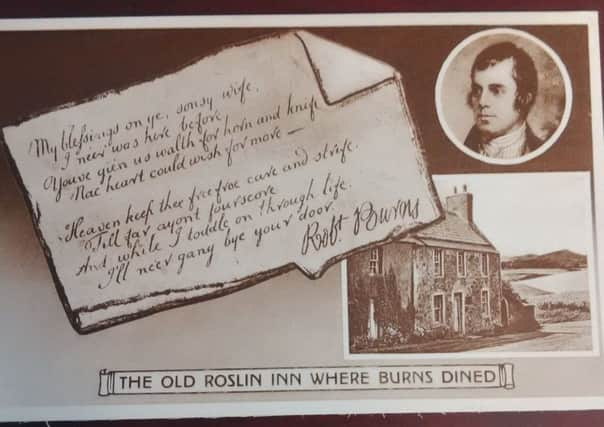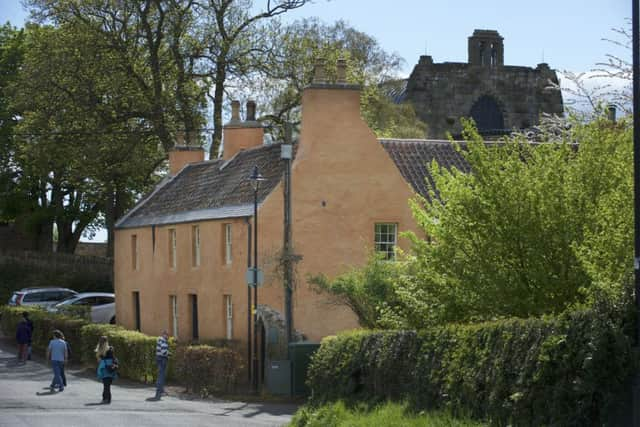Former inn hailed in verse by Robert Burns opens again


Collegehill House, next to Rosslyn Chapel in Midlothian, has re-opened following a long programme of conservation and restoration.
The property, which is now used as holiday accommodation, was built as an inn in 1660 and offered ale, bed and meals for 200 years with visitors recalling “groaning tables” of hung beef, tongue, cold fowls, toast and jelly.


Advertisement
Hide AdRobert Burns was one of many influential Scots who soaked up the delights of Roslin Inn. He visited for breakfast in 1787 with his friend, painter Alexander Naysmith, after walking from the capital to watch the dawn.
Such was his gratitude, Burns rewarded the landlady, Annie Wilson, with two verses scratched on to a pewter plate, part of which read “Ye’ve wealth o’ gear for spoon and knife: Heart could not wish for more.”
Ian Gardner, Director of Rosslyn Chapel Trust, which looks after the building, said: “The nice thing is the building was created as an inn and is still providing accommodation today.
“Collegehill has a lot of history and I think that is really driven by its prominent location next to Rosslyn Chapel. People came to visit the chapel and then visited the inn.
“We have finished a major programme of conservation and repair, both to the exterior and interior, meaning it will be appreciated by those passing by, and those staying as guests and ensuring the continuation of this former inn’s long tradition of welcoming guests to the area.’
Burns was not alone in his fond regard for the inn, now a B-listed building, with James Boswell and Dr Samuel Johnson taking tea there on their return from the Hebrides.
Advertisement
Hide AdIn 1803, William and Dorothy Wordsworth stayed at the inn so they could visit Walter Scott and his wife at their house in Lasswade.
Dorothy recorded the visit in her diary, which has become a valuable record of 19th Century inns across Scotland. She wrote: “We ordered dinner on our return to the inn, and went to view the inside of the Chapel of Roslin, which is kept locked up and so preserved from idle boys.”
Advertisement
Hide AdA number of names and signatures of guests who stayed at the inn have been etched into the windowpanes throughout the house.
“The earliest dates to around 1820, but most are 1850-70, and seems to have been a tradition for people staying in the inn at that time,” Mr Gardner added.
The windows have been conserved by The Scottish Glass Centre in Glasgow.
Generations of the Wilson family acted as both innkeepers and custodians of neighbouring Rosslyn Chapel.
In the early 19th Century, those duties fell to Annie Wilson and an article in The Gentleman’s Magazine of 1817 says that ‘she has held this office a great number of years and, during this period, to use her own words ‘ha puttit three gude men aununder the yearth’.
When Annie died, her daughter Margaret and husband James took over the tenancy. A visitor in 1823 wrote ‘By nine we were seated in the little inn at Roslin, eating a true Scotch breakfast. The table groaned beneath hung beef, tongue, cold fowls, hot beef steaks, rolls, toast, jelly and marmalade.
Advertisement
Hide AdThe inn was built by Sir John St Clair, 17th Baron of Rosslyn, with stone likely quarried from the ruins of Rosslyn Castle, which was attacked in 1650, for the job.
In 1866, the inn relocated to the village and the building became the home of the Earl of Rosslyn’s factors and chapel custodians. It was also used as the first Masonic Lodge in the village with meetings held there
until 1911.
Advertisement
Hide AdCollegehill, which is owned by the Earl of Rosslyn was opened up as visitor accommodation in 2012 by the Landmark Trust. The Rosslyn Chapel Trust carried out the recent renovations.
The building has been re-harled and lime washed with repairs carried out to the roof, chimneys, and conservation repairs.
Douglas Walker of Page\Park Architects, who oversaw the project, said: “ The careful conservation, restoration and renovation works at Collegehill House have given the house a new lease of life.
“Page\Park‘s role overseeing this work has led to a faithful upgrading of the historic fabric with a new interior upgrade which lifts the quality of accommodation while maintaining the unique character of the house.’
